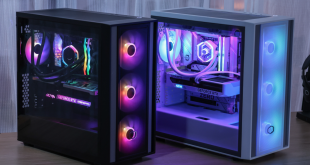For a mid-tower case, the Obsidian 650D is quite large. Some manufacturers would try and disguise this be incorporating a series of curved plastic panels but Corsair has opted for a much more simple square design for the case. This is no bad thing, though, as the 650D is actually quite attractive to look at.
Corsair have chosen to finish the front of the 650D in black brushed aluminum which looks and feels much more exclusive than steel or plastic. Even though the rest of the case is constructed from steel, this seems to be good quality and gives it a reassuring weight.
The front panel connections are disguised behind a flap which opens to reveal pretty much everything we could ask for. From left to right there are two USB3.0 ports, headphone and microphone jacks, two USB2.0 ports and a firewire port. The power button is illuminated white when the system is on and is located on the left side of the front panel flap next to the HDD access LED.
The reset button is hidden beneath the flap, though, to the right of all the connections. On the top of the case at the front there is a small flap which slides back to reveal a hard drive docking station. There is also a fan speed control located under this flap which lets you tweak the noise level of the case.
In the roof of the case there is a sizable fan grille which has mounting points for pretty much every fan configuration you could want. The case is supplied with a 200mm exhaust fan installed but this can be replaced by two 140mm fans or two 120mm fans. There is an additional 200mm fan in the front of the case which acts as an intake. This is covered by a removable mesh panel which has an integrated dust filter.
Moving round to the rear of the case we find the usual 120mm exhaust vent populated with a Corsair branded fan. The case features eight vented expansion slots and two external watercooling holes which contain rubber grommets to stop dust from getting in.
The PSU mountings are located at the bottom of the case with a vent on the underside to feed the fan with cool air. This vent features a dust filter which can be easily removed from the rear of the case.
 KitGuru KitGuru.net – Tech News | Hardware News | Hardware Reviews | IOS | Mobile | Gaming | Graphics Cards
KitGuru KitGuru.net – Tech News | Hardware News | Hardware Reviews | IOS | Mobile | Gaming | Graphics Cards








